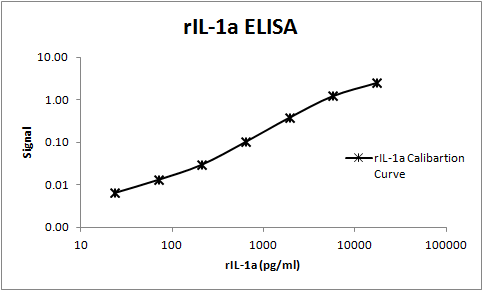Recombinant Rat IL-1 alpha/IL-1F1 Protein Summary
Product Specifications
Ser115-Ser270
Analysis
Product Datasheets
Carrier Free
CF stands for Carrier Free (CF). We typically add Bovine Serum Albumin (BSA) as a carrier protein to our recombinant proteins. Adding a carrier protein enhances protein stability, increases shelf-life, and allows the recombinant protein to be stored at a more dilute concentration. The carrier free version does not contain BSA.
In general, we advise purchasing the recombinant protein with BSA for use in cell or tissue culture, or as an ELISA standard. In contrast, the carrier free protein is recommended for applications, in which the presence of BSA could interfere.
500-RL
| Formulation | Lyophilized from a 0.2 μm filtered solution in PBS with BSA as a carrier protein. |
| Reconstitution | Reconstitute at 100 μg/mL in sterile PBS containing at least 0.1% human or bovine serum albumin. |
| Shipping | The product is shipped at ambient temperature. Upon receipt, store it immediately at the temperature recommended below. |
| Stability & Storage: | Use a manual defrost freezer and avoid repeated freeze-thaw cycles.
|
500-RL/CF
| Formulation | Lyophilized from a 0.2 μm filtered solution in PBS. |
| Reconstitution | Reconstitute 5 µg vials at 50 µg/mL in sterile PBS. Reconstitute 25 µg or larger vials at 100 µg/mL in sterile PBS. |
| Shipping | The product is shipped at ambient temperature. Upon receipt, store it immediately at the temperature recommended below. |
| Stability & Storage: | Use a manual defrost freezer and avoid repeated freeze-thaw cycles.
|
Reconstitution Calculator
Background: IL-1 alpha/IL-1F1
Interleukin 1 (IL-1) is a name that designates two proteins, IL-1 alpha and IL-1 beta, which are the products of distinct genes, but which show approximately 25% amino acid (aa) sequence identity and which recognize the same cell surface receptors. Although IL-1 production is generally considered to be a consequence of inflammation, evidence suggests that IL-1 is also temporally upregulated during bone formation and the menstrual cycle and can be induced in response to nervous system stimulation. In response to classic stimuli produced by inflammatory agents, infections or microbial endotoxins, a dramatic increase in the production of IL-1 by macrophages and various other cells is seen. Cells in particular known to produce IL-1 include osteoblasts, monocytes, macrophages, keratinocytes, Kupffer cells, hepatocytes, thymic and salivary gland epithelium, Schwann cells, fibroblasts and glia (oligodendroglia, astrocytes and microglia).
IL-1 alpha and IL-1 beta are both synthesized as 31 kDa precursors that are subsequently cleaved into proteins with molecular weights of approximately 17,000 Da. Neither precursor contains a typical hydrophobic signal peptide sequence and most of the precursor form of IL-1 alpha remains in the cytosol of cells, although there is evidence for a membrane-bound form of the precursor form of IL-1 alpha. The IL-1 alpha precursor reportedly shows full biological activity in the EL-4 assay. Among various species, the aa sequence of mature IL-1 alpha is conserved 60% to 70% and human IL-1 has been found to be biologically active on murine cell lines. Both forms of IL-1 bind to the same receptors, designated type I and type II. Evidence suggests that only the type I receptor is capable of signal transduction and that the type II receptor may function as a decoy, binding IL-1 and thus preventing binding of IL-1 to the type I receptor.
- Dower, S.K. and J. Z. Sims, (1994) Guidebook to Cytokines and Their Receptors, Nicola, N.A., ed., Oxford University Press, New York p. 17.
Citations for Recombinant Rat IL-1 alpha/IL-1F1 Protein
R&D Systems personnel manually curate a database that contains references using R&D Systems products. The data collected includes not only links to publications in PubMed, but also provides information about sample types, species, and experimental conditions.
5
Citations: Showing 1 - 5
Filter your results:
Filter by:
-
BST106 protects against cartilage damage by inhibition of apoptosis and enhancement of autophagy in osteoarthritic rats
Authors: JM Hong, JK Shin, JY Kim, MJ Jang, SK Park, JH Lee, JH Choi, SM Lee
Biol. Pharm. Bull., 2018-05-23;0(0):.
Species: Rat
Sample Types: Whole Tissue
Applications: Bioassay -
NG2 glial cells regulate neuroimmunological responses to maintain neuronal function and survival
Authors: M Nakano, Y Tamura, M Yamato, S Kume, A Eguchi, K Takata, Y Watanabe, Y Kataoka
Sci Rep, 2017-02-14;7(0):42041.
Species: Rat
Sample Types: In Vivo
Applications: In Vivo -
Interleukin 1 alpha (IL1A) is a novel regulator of the blood-testis barrier in the rat.
Authors: Sarkar O, Mathur PP, Cheng CY, Mruk DD
Biol. Reprod., 2007-12-05;78(3):445-54.
Species: Rat
Sample Types: In Vivo
Applications: In Vivo -
Alpha-4/beta-1 and alpha-L/beta-2 integrins mediate cytokine induced lung leukocyte-epithelial adhesion and injury.
Authors: Parmley LA, Elkins ND, Fini MA, Liu YE, Repine JE, Wright RM
Br. J. Pharmacol., 2007-09-10;152(6):915-29.
Species: Rat
Sample Types: In Vivo
Applications: In Vivo -
The injury response of oligodendrocyte precursor cells is induced by platelets, macrophages and inflammation-associated cytokines.
Authors: Rhodes KE, Raivich G, Fawcett JW
Neuroscience, 2006-04-21;140(1):87-100.
Species: Rat
Sample Types: In Vivo
Applications: In Vivo
FAQs
No product specific FAQs exist for this product, however you may
View all Proteins and Enzyme FAQsReviews for Recombinant Rat IL-1 alpha/IL-1F1 Protein
Average Rating: 5 (Based on 1 Review)
Have you used Recombinant Rat IL-1 alpha/IL-1F1 Protein?
Submit a review and receive an Amazon gift card.
$25/€18/£15/$25CAN/¥75 Yuan/¥2500 Yen for a review with an image
$10/€7/£6/$10 CAD/¥70 Yuan/¥1110 Yen for a review without an image
Filter by:



